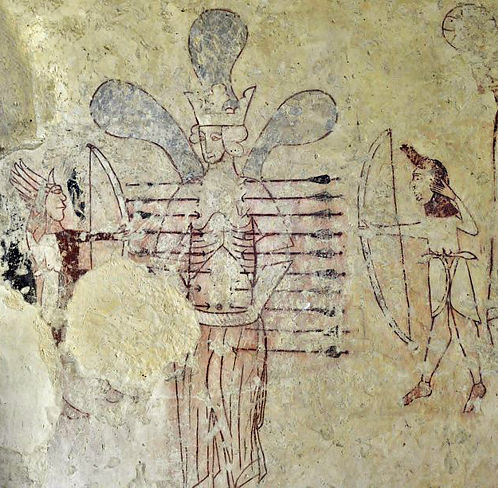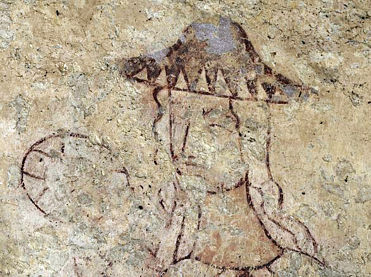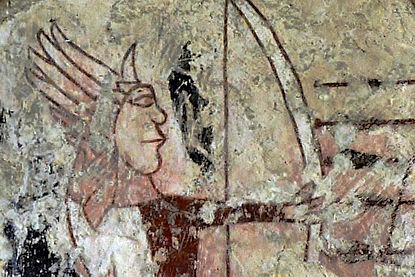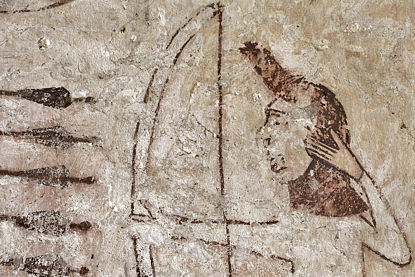Stoke Dry, Rutland (†Peterborough) C.14
Martyrdom of St Edmund

The partly-visible figure at the extreme right is St Christopher, now on the site in his complete form. The rest of the photograph shows the Martyrdom of St Edmund. He is bound to a very stylised tree and wears his crown but is semi-naked, dressed only in a tunic that has been stripped from his shoulders, the top part thus dangling below his waist The anatomy of his ribcage is very carefully delineated and his crossed feet seem to be bound.
The many arrows piercing him are precisely and symmetrically arranged – whether they were drawn freehand or ruled with a straight-edge is impossible to say now.
Two archers are shooting at Edmund, the one on the left wearing a conventional bi-coloured tunic, the one on the right in a rather strange garment apparently wrapped around his waist and fastened with a knotted belt. But he wears tight leggings-type hose too, the bottom edge of which shows at his ankles. His arms are not bare – there is a line at his left wrist which is presumably the sleeve-edge of a very tight tunic.
The most interesting thing about the archers is their (apparently) feathered headgear, which has led to much speculation about their resemblance to Americans Indians, at least as they were depicted in the art of the Old World after the Voyages of Discovery in the 16th century. The obvious difficulty here is the date.
It would, I suppose, be possible to construct a hypothesis as follows: early Norse explorers such as Erik the Red and his son Leif Eriksson encountered in Greenland or the far north of the American continent indigenous peoples who wore feather headdresses similar to those of the stereotypical ‘Red Indian’ known to every Western movie-goer of the last fifty years. They brought stories and descriptions of the strange people back to Europe, whence they were disseminated even to distant inland locations like Stoke Dry. Because the strangely dressed people in the stories were obviously pagans, and possibly also because the tellers of the tales were the descendants of the pagan Northmen responsible for Edmund’s death, feathered headgear, paganism, perhaps also folklore about what the Danish raiders who had penetrated inland as far as nearby Stamford had worn and looked like, became inextricably linked in the minds of local people. When the painter (who was probably also a local man) made the Martyrdom of St Edmund at Stoke Dry, his ideas about how to depict pagan ‘barbarian’ assassins came straight out of this set of notions.

As with many unlikely hypotheses, there may be a grain of truth here, but the objections are manifold¹. Strange hats and headgear were commonly used in medieval painting of all kinds to signal paganism, barbarianism and generally undesirable persons, ‘foreign’ or otherwise. (Christ and his disciples went bareheaded; Judas may have worn a hat). But perhaps we need look no further than the lampshade-like object worn on his head by St Christopher (still technically a pagan when he carried Christ across the river) in the photograph at the left. The general shape of this hat is similar to standard pilgrim’s headgear, but it is a strangely exotic version, and I have never seen anything resembling it in an English St Christopher painting before.
More specifically for this painting, it probably was believed at this period that the Norsemen wore horns on their heads, or helmets, and the odd projections coming from the heads of both archers (the one on the right also a wears a familiar enough hood or coif covering head and shoulders down to collar-bone level) may simply be intended for these. One way or another, I am sure that they come from the Old World and not the New.


Finally, were the Stoke Dry paintings made by the same hand as those at Old Weston? The distance between the two places is not great, and Clive Rouse is quoted in the newspaper article referred to in Note 1 below as remarking that the Stoke Dry St Edmund is the work of ‘a recognised artist’. He may well have meant the Old Weston painter. Follow the link to see the similarities.
Website for St Andrew’s, Stoke Dry
¹ I labour this point simply to correct any impression that may be given by a local newspaper article displayed in the church that Rouse, who saw and photographed this painting, believed the ‘American Indians’ theory, which seems to me very unlikely. He reproduces the painting in Medieval Wall Paintings (p.6), but is otherwise silent about it.